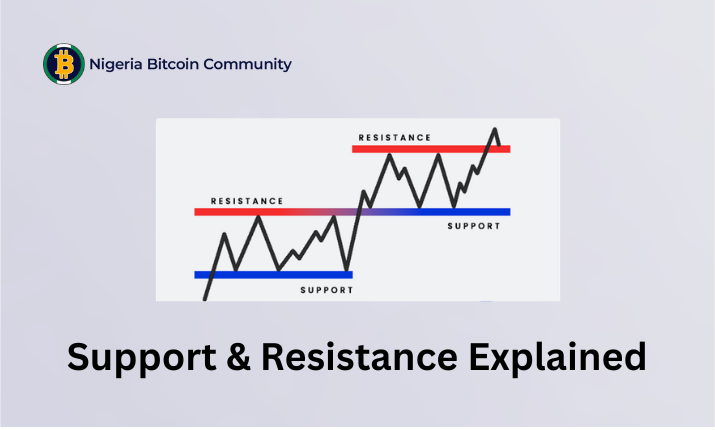Most traders think they’re trading support and resistance.
But in reality, they’re just drawing random lines on a chart.
And that’s exactly why so many get stopped right before the market takes off in the direction they expected.
In this post, I’ll explain:
- What support and resistance really are
- Why they fail so often
- The method I use instead, the one that has given me my most consistent wins and highest risk-to-reward trades
Let’s get down to business.
What Support and Resistance Actually Are
Let’s start with the basics.
Support is a price area where the market struggles to go lower. When the price falls into this zone, it often bounces back up.
Resistance is a price area where the market struggles to go higher. When the price rises into this zone, it often drops back down.
When support breaks, it can turn into resistance.
And when resistance breaks, it can turn into support.
Most traders understand this concept.
But then, support and resistance come with some problems.
Let’s discuss that below.
3 Problems of Support and Resistance
Here’s where things break down in real market conditions.
The issues with support and resistance are that:
i. They’re subjective
No two traders draw them the same way.
Some use the wick, others use the body, and some mark the entire region.
The result? Inconsistent outcomes.
ii. They’re liquidity zones
Smart money knows retail traders place stop-losses just below support or just above resistance.
So they use these zones to hunt stops and trap traders.
iii. They fail more often than people admit
These levels aren’t walls. They’re just areas where price has reacted before.
If the market wants to move through them, it will, regardless of how many times the price bounced there in the past.
Think about it:
How many times have you placed a trade at support or resistance, only for the price to stop you out and then reverse in the exact direction you expected?
That’s not bad luck.
That’s how the market works.
But in the next subheading, I will show you what I use instead of support and resistance.
Support and Resistance Alternative: Psychological Levels
Instead of relying on subjective lines, I focus on psychological levels.
These are round numbers that markets naturally gravitate toward.
Institutions and big players often take profits at these levels, which makes them powerful reversal points.
- In Forex, psychological levels are the last three digits after the decimal: 000, 250, 500, 750.
- In Crypto (like Bitcoin), they are the last three digits before the decimal: 000 and 500.
Here’s what that looks like:
| Pair | 1st Level | 2nd Level | 3rd Level | 4th Level | 5th Level |
|---|---|---|---|---|---|
| EURUSD | 1.16000 | 1.16250 | 1.16500 | 1.16750 | 1.17000 |
| GBPJPY | 198.000 | 198.250 | 198.500 | 198.750 | 199.000 |
| BTCUSDT | 188,000.59 | 188,500.54 | 189,000.48 | 189,500.97 | 190,000.85 |
But here’s the catch – Don’t trade these levels blindly.
I will explain what I mean by this in the next section.
Keep reading.
How I Trade Psychological Levels (With Confluence)
Psychological levels alone can lead to numerous false trades.
That’s why I only trade them when they align with confluence factors.
Confluence in trading means combining several indicators or analysis methods that point in the same direction to strengthen the reliability of a trade setup.
The factors I work with include:
- A supply or demand zone at or near that level
- A break in the structure leading into the level
- A liquidity sweep — price grabs liquidity at the level before reversing
When all three align, the setup has a much higher probability.
It offers a better risk-to-reward ratio than just trading basic support or resistance lines.
Support & Resistance vs. Supply & Demand: Clearing the Confusion
Many traders confuse support & resistance with supply & demand zones, but they’re not the same.
- Support & resistance: reaction points where price bounced or dropped in the past.
- Supply & demand: the origin of strong moves, where institutions placed large orders.
Supply and demand zones are more precise, more reliable, and far more powerful when combined with psychological levels and liquidity concepts.
Final Thoughts
If you’ve been struggling with support and resistance trading, you’re not alone.
The reason these levels fail so often isn’t because you’re unlucky; it’s because they’re designed to trap retail traders.
By shifting your focus to psychological levels, combined with supply and demand zones, structure breaks, and liquidity sweeps, you’ll start trading alongside smart money, not against it.
Want to see exactly how to use this strategy in real time?
Join our private trading community, where we share setups like this before they even play out.
You can also join our mentorship session and get trained to be a pro trader.
You can check out our trading calculator to help you trade safely.
Now, over to you. Let me hear from you:
Are you an ardent user of support and resistance? How has that worked out for you?
What other confluence factors do you use?
Let me know in the comments below.



0 Comments